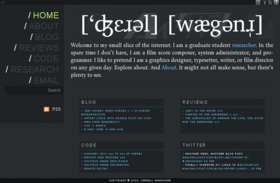2012 0003 0020
Every few years, when I’m not teaching introductory web programming, I revisit front end development, oftentimes in the form of retooling my site. Last time, it was a Wordpress-driven theme with cobbled-together JavaScript snippets for random bits of functionality:
Serviceable, at least.
Before this, I used a generic Wordpress theme, the specifics of which I don’t recall. Rolling back all the way to the mid-90s, I had a fortunecity site, which was–as typical of sites in the 90s–equal parts bland and garish:
Yes, it had a Christmas theme for the title page. And yes, the header, navigation bar, and footer (on individual pages) are all java applets. Not exactly, a usability panacea.
And now, I’ve transitioned to Jekyll, for a few reasons:
- It’s hard to get faster than static pages for serving content.
- Github can handle more traffic than the shared hosting I was using previously.
- A Jekyll deploy on github can’t use external plugins. Which is, by most accounts, a downside, but it forces me to find front-end solutions for what I want rather than turning to the back end for everything.
- I wanted to build everything from scratch. The limited Liquid
DSL used by Jekyll is leaner than full-blown
PHP, and more satisfying for building from the ground-up (all my Wordpress themes started from–at minimum–a skeleton theme, just to cover the essentials needed by Wordpress). - Having everything in a git repo is both satisfying for my current work flow and avoids the pain of database backups.
So here it is. I avoided jQuery (convenient as it is) to keep
things lean and loading quickly, and rampantly bludgeoned the site with
HTML5/CSS3 without much regard for backwards compatibility. To
further optimize queries, I used Liquid includes to aggregate all
the js and css into single files. For JavaScript:
---
---
(function () {
"use strict";
{% include cookies.js %}
{% include mini-clock.js %}
{% include check-time.js %}
{% include event-handler.js %}
}());you can wrap everything with "use strict" to get some extra
exception goodness. Doing this may cause JSLint to complain
about indentation issues, and if you don’t add event handlers with
JavaScript (e.g. you use the onclick or onload events in your
HTML tags), you may run into scope issues as well. All of this
together provided a nearly 20-point speed bump on
Google page speed.
I opted for a dual-themed site, determined by the time of day. The clock drawn in the HTML5 Canvas element in the upper-left shows when the transition will occur, or you can override it with the icon next to the clock.
All in all, a good transition so far.

